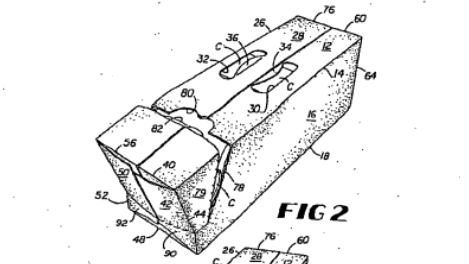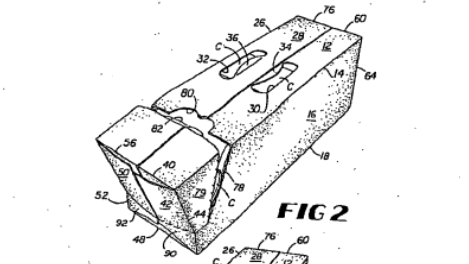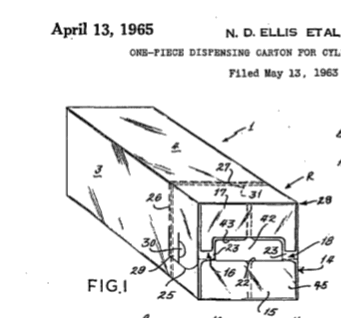
|
C.W.
Zumbiel Comp. Inc., v. Kappos
(Director) & Graphic Packaging Int’l Inc. Fed
Cir. 2011-1332, -1333 December
27, 2012 判決文(原文) Summarized
by Tatsuo YABE March
19, 2013 |
本事件で問題となったGraphic社の米国特許第6,715,639号はアメリカのグロサリーショップの食品棚で良く見かける1〜2ダース入りの炭酸飲料水(コーラー、スプライト、・・・)或いはビールを収容するカートンボックスに関する発明であり、当該カートンボックスの前方部を開口するための破断線78, 80と破断をするために指を差し込むfinger flap 82の位置を規定したクレームを含む。 問題となった従属クレーム2では、指差込み用折込部(finger flap 82)が上側パネル面において、上列の隣接する第1と第2容器との間に形成されている(指がはいりこむスペースがある)と規定している。

CAFCは2(Moore判示とWallach判示):1(Prost判事)で当該従属クレームの非自明性を支持した。 即ち、いずれの引例にも第1容器と第2容器の間の位置にfinger
flapを形成することで指を差し込み、破断線に沿って除去部(dispenser)を開口しやすいという構造は開示或いは示唆されていない。 Prost判事は多数意見に一部反対であり、従属クレーム2の特徴は、所詮は破断線をカートンのどこに設けるかであり、非常に限られた選択肢の中から当業者であれば当然缶と缶との間に設けるというのは常識であろうと述べている。
CAFC判決では言及されていないが、今回の事件ではまさにGraham判決(合衆国最高裁判決:1966年)の4つ目の事実要件である客観的証拠、即ち、この従属クレーム2の特徴に直接起因する商業上の成功、他社のライセンス申込みなどで際立った証拠を提示できたのではないだろうか?
いずれにせよ、本事件の特許は久々のスーパー・ローテク(中学生の技術家庭科レベル)なものです。 米国特許の自明性の判断基準の学習あるいはグループディスカッションするのに良い題材になると思います。(筆者)
*******************************************************
(以下、本事件で審理された従属クレーム2に対する判決文の概要)
本事件は、当事者系再審査のPTOの最終結果(審決)を不服とし、被疑侵害者であるZumbiel社がCAFCに控訴したことによるCAFC判決である。 特許権者はGraphic社で、問題となった特許はUSP6,715,639で、複数のボトル或いは缶を収容するカートン(あるいはボックス)に関する発明をクレームしている。 問題となったクレームで代表的なものはクレーム1とその従属クレーム2であり、特に従属クレーム2が非自明と判断された理由に的を絞って以下にその概要を述べています。
(1)Graphicの米国特許第6715639号
USP6715639のクレーム1は
|
Claim
1 reads: |
|
|
1.
An enclosed carton for carrying a plurality of containers in two rows,
with a top row and a bottom row, said containers each having a diameter,
the carton comprising: a.
a top panel, side panels, a bottom panel, and closed ends, at least one of
which is an exiting end; b.
a dispenser which is detachable from the carton to form an opening at an
exiting end through which the containers may be removed; c.
the dispenser being a unitary structure comprising a portion of the top
panel, portions of the side panels, and a portion of the exiting end, said
portions being defined by a
tear line
extending
across the top panel, side panels,
and
exiting end; d.
means for preventing the end container in the bottom row from accidentally
rolling out of the carton after the dispenser has been opened,
the height of the means above the bottom panel being less than the
diameter of said end container; and e.
a
finger flap(82) located
along the portion of the tear line extending across the top panel for
pulling
the dispenser open along the tear line, f.
whereby when the dispenser is opened it may optionally remain attached to
the carton at the exiting end to form a basket at the exiting end of the
carton. The
reference numeral was added. |
|
であり、従属クレーム2では、指差し込み用折込部(finger
flap 82)の場所がカートンボックスの上面で上側列の第1と第2の容器の間に位置することを規定している。 (下線部の特徴はクレーム1で既に規定)
2.
The
carton of claim 1, in which the finger flap (82)
is located between the first and second containers in the top row.
The reference numeral was
added.

(2)先行技術文献:
先行技術として引用されたものは以下を含む:
(2−A) Ellis引例
|
A.
Prior Art: Ellis United
States Patent No. 3,178,242 (“Ellis”) discloses a carton for holding
cans with a detachable dispenser piece which is detached from the carton
along the tear line. The following are illustrative of Ellis: |
|
|
|
Ellis
describes carton 1, bottom wall 2, left side wall 3, top wall 4, right
side wall 5 and cans C. Ellis col. 1 ll. 62-69. Items
21, 25, 26 and 27 form the tear-line around the part of the carton R which
are opened to dispense cans. Id.
col.
2 ll. 30-49. A
user opens the carton by inserting a finger into hole 30, pulling up on
tab 29 and tearing items 21, 26, and 27. Id.
col.
3 ll. 26-31. According to Ellis, from the front portion, the tear-line is
“a distance more than one half
diameter and less than one diameter of one can, preferable. |
Additionally,
Ellis’s figures 1 and 2 show items 21, 25, 26, and 27, which form a single
tear-line through the part of the carton R that is opened for dispensing cans.
Ellis col. 2 ll. 22-49.
Ellis
expressly recites: To open the carton, a person simply inserts a finger
partially into the hole 30 and pulls up on the side tab 29 and rips the scores
26, 27, and 26 in the side and top walls 3, 4, 5. The scores 21 in the side
front flaps 16 and 18 are then severed to remove the entire removable section R
as a unit.
Ellis引例のカートンを開口するには、開口穴30に指を部分的に差し込み、サイドタブ29を上方に引き上げ、破断部26,27,26を破り、さらに、サイドフラップ16,18を破断し、除去可能部R全体を取り外す。

(2−B) German‘718引例
|
B.
Prior Art: German ’718 German
Gebrauchsmuster No. G85 14718.4 (“German ’718”) discloses a carton
for containers with a dispenser piece opened by a finger flap. The
following are illustrative of
German ’718: |
|
|
|
German
’718 describes a carton having side walls 1, end walls 2, top side 3,
cover parts 4, tear-lines 5 and 6, and finger hole 9 on top used to tear
open cover part 4. |
(2−C) Edgerton引例
|
C.
Prior Art: Edgerton United
States Patent No. 5,372,299 (“Edgerton”) describes a box made from
flat cardboard having perforated lines. The following is illustrative of
Edgerton: |
|
|
|
Edgerton
discloses a panel having fold lines 14”, 16”, 18” and 20”.
Edgerton col. 3 ll. 5-17. The specification discloses that the “fold
lines . . . could, if desired be perforated or scored.” Id.
col.
4 ll. 19-24. |
(2−D) Palmer引例
|
D.
Prior Art: Palmer United
States Patent No. 2,718,301 (“Palmer”) discloses |
|
|
|
a
package for canned goods which may be carried using one hand. The
following is illustrative of Palmer: |
(3)自明性判断の基準:
(3−A)米国特許法第103条(a): 自明性を規定した条文
(3−B)In re Gartside
(Fed Cir 2000): 発明が自明であるか否かの最終結論は事実を基にした法的判断事項である。依って、審判部の法的判断に対しては
de novo基準で審理し、事実判断に対しては、substantial
evidenceの基準で審理する。
(3−C)KSR合衆国最高裁判決(2007年):自明性の判断は、Graham
v. John Deere合衆国最高裁判決(1966年)で判示された4つの事実要件、(a)引例の開示内容とその範囲;(b) 引例とクレームされた発明との相違点;
(c) 当業者のレベル; (d) 客観的考察事項、 を基礎とする法律問題である。
(4)当事者系再審査の結果と審決:
独立クレーム1(8,13)はGerman’718特許に鑑みEllis特許によって自明である。
従属クレーム2(9,14)は非自明である。
(5)従属クレーム2が非自明と判断された理由:
本事件の重要な争点のひとつは従属クレーム2(指差込み用折込部が上側パネル面において、上列の第1容器と第2容器との間に形成されている)がGerman引例、さらにPalmer引例に鑑みEllis引例によって自明であるか否かである。 注意:下線部はクレーム1で既に限定されている。
Zumbielは、639特許或いはPalmer特許のように隣接する缶の間に指差込み用折込部を設けることの利点(カートンに指を差し込むときに缶が障害とならない)を当業者であれば理解できたであろうと主張したが、審判部はEllis引例の破断線を移動させることに対する十分な教示がPalmer引例には存在しないと判断した。 Palmerの指差込み用折込部はカートンを搬送するときにカートンを指で保持するためのものであって、639特許のようにカートンを破るためのものではない。さらに、Ellis引例の破断線の位置はクレーム2で規定している位置に設けることはできない。 寧ろ、Ellis引例は、その破断線を第1容器と第2容器の間に設けることを否定(teaches
away)している。 Ellis引例のコラム2、31−33行目に記載されているように、Ellis引例の破断線は缶径の0.5倍から1倍の間の位置に、好ましくは0.75倍の位置に設定することが望ましい。 このようにEllis引例には破断線を設ける位置のレンジを明瞭に開示している。
さらに、Zumbielは、ジョージア北部地区連邦地裁における他事件におけるGraphicの自認(下列と上列の缶の配置の仕方に関する自認)を基礎とし、Ellis引例の図3を改編した図(以下参照)を提示し、Ellis引例で開示されている缶の配列(staggered
arrangement)ではなく下列の缶の真上に上列の缶を配列する(stacked
arrangement)場合にはEllis引例で開示された破断線の位置(缶の直径の0.5倍から1倍の位置)において639特許の従属クレーム2の特徴を満たすと反論した。
|
Ellis Fig. 3 (Staggered arrangement) |
Annotated Fig. 3 (Stacked arrangement) Zumbiel社がEllis引例の図3を基に独自に作成した図 |
|
|
|
しかし、Palmer引例においてEllis引例の破断線の位置を移動させることに対する教示が存在しないこと、Ellis引例において破断線の設定位置のレンジが明白に記載されていること、さらに、Zumbielの複雑な反論(Ellis引例の図3を改編した状態を想定した議論)には説得性がないとしてCAFCは審決を支持した。 依って、従属クレーム2はPalmer引例とGerman’718引例に鑑みたEllis引例によっても非自明であると判断する。
さらに、Zumbielはクレーム1のプレアンブルで言及されている容器(Container)はクレームの積極的な構成要素とはみなされないと反論したが、クレームの本文中で参照されている場合、あるいは、クレームのボディ(本文)を理解するのに本質的な要素である場合にはクレームの構成要素として解釈される(Allen
Eng’g Corp v. Bartell Indus: Fed Cir. 2002;
Catalina Marketing Int’l Inc. v. Coolsavings.com Inc: Fed Cir. 2002)。
上記理由により639特許のクレーム1,8,13を自明、且つ、クレーム2,9,14を非自明であるとした審決を支持する。